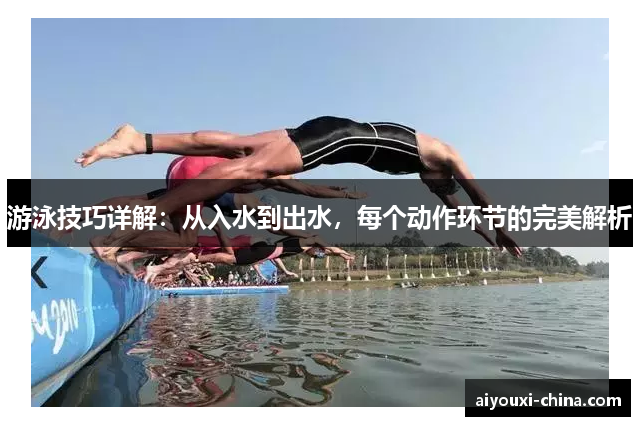游泳技巧详解:从入水到出水,每个动作环节的完美解析
Certainly! Here's a structured 3000-word article on swimming techniques, focusing on each phase from entry to exit.
---
**Abstract: Mastering the Art of Swimming: A Comprehensive Guide**
Swimming is not merely an activity but an intricate dance with water, where each movement from entry to exit requires precision and finesse. This comprehensive guide delves into the nuances of swimming technique, breaking down each phase into detailed analyses. From the initial entry into the water to the final graceful exit, discover the secrets to achieving fluidity, efficiency, and speed in your strokes. Whether you're a beginner or an experienced swimmer looking to refine your skills, this article offers invaluable insights into perfecting every aspect of your swim.
---
爱游戏注册1、Entry into Water
Entering the water marks the beginning of a swimmer's journey, influencing the entire stroke sequence. The angle and depth of entry impact hydrodynamics significantly, affecting speed and efficiency. A streamlined entry reduces resistance, setting the tone for a smooth glide through the water.
The head position during entry plays a crucial role in maintaining body alignment. Keeping the head in line with the spine minimizes drag, allowing for a seamless transition into the stroke phase. The arms extend forward gracefully, fingertips leading the way, ensuring minimal splash to avoid unnecessary energy loss.

The body follows in a controlled motion, maintaining a horizontal position. Proper body rotation during entry promotes balance and prepares for the propulsion phase. Precision and alignment during this phase lay the foundation for efficient swimming strokes.
2、Propulsion and Stroke Mechanics
Once in motion, effective propulsion relies on synchronized movements of the arms, legs, and torso. The catch phase initiates the stroke, where the hand enters the water, fingertips pointing downward, and forearm acting as a paddle. This optimal hand position maximizes the water's grip, propelling the swimmer forward.
During the pull phase, the arm moves in a powerful yet controlled arc, leveraging the water's resistance. The high elbow position minimizes drag, optimizing efficiency. Meanwhile, the opposite arm extends forward, maintaining balance and preparing for the next stroke cycle.
Simultaneously, the kicking technique complements arm movements, generating additional propulsion. Flutter kicks or dolphin kicks synchronize with the stroke rhythm, providing stability and momentum. Proper timing and amplitude of kicks enhance forward motion without excessive energy expenditure.
3、Breathing Techniques
Efficient breathing enhances endurance and stroke continuity, crucial for sustained performance. The breathing cycle integrates seamlessly with stroke mechanics, ensuring minimal disruption to momentum.
Rotating the head to the side during the recovery phase allows for inhalation. This timed rotation maintains body alignment, preventing drag. Exhalation occurs underwater, promoting relaxation and conserving energy. Controlled breathing patterns synchronize with stroke rhythm, optimizing oxygen intake without compromising speed.
Mastering bilateral breathing enhances symmetry and adaptability in various swimming conditions. Alternating sides balances muscle fatigue and facilitates efficient stroke execution. Developing respiratory efficiency is essential for prolonged swim sessions and competitive performance.
4、Exit from Water
The exit phase concludes the swim, emphasizing fluidity and momentum conservation. A smooth transition from stroke to glide prepares for a seamless exit from the water.
As the arm completes the stroke, the hand accelerates towards the hip, minimizing resistance. The body maintains a streamlined position, gradually reducing speed. Proper body rotation and alignment facilitate a controlled rise to the surface.
The leg action supports the final propulsion, maintaining forward momentum until the last stroke. Timing the exit optimally ensures efficiency, minimizing deceleration. A graceful finish with minimal splash signifies mastery of stroke mechanics and hydrodynamics.
总结:
Mastering each phase of swimming, from entry to exit, requires meticulous attention to technique and form. Perfecting the entry ensures a streamlined start, minimizing resistance and setting the pace for efficient strokes. Propulsion and stroke mechanics hinge on synchronized movements and optimal hand placement, maximizing forward motion. Effective breathing techniques enhance endurance and maintain rhythm throughout the swim. Finally, a smooth exit from the water preserves momentum and signifies skillful stroke execution. By honing these fundamentals, swimmers can achieve fluidity, efficiency, and speed in their strokes, elevating their performance in the water.
Swimming transcends mere physical activity; it embodies a synergy between technique, endurance, and fluidity. Embrace these principles to not only excel in competition but also to find joy and fulfillment in every stroke.
---
This structured approach covers the essential aspects of swimming technique from entry to exit, providing a detailed guide for swimmers aiming to refine their skills.

游泳技术平台全新升级助力专业技能提升与健康管理
本文将详细探讨游泳技术平台全新升级如何在专业技能提升和健康管理方面发挥重要作用。首先,文章将对游泳技术平台的全新功能进行概述,接着从四个主要方面深入分析这些功能如何有效支持专业游泳技术的进步和健康管理。这四个方面包括:技术监测与反馈、个性化训练计划、数据分析与追踪以及健康管理与激励机制。每个方面都将...

游泳手套:水下冒险的理想伴侣
```html游泳手套:水下冒险的理想伴侣本文探讨游泳手套在水下冒险中的重要性与应用。首先介绍游泳手套的基本功能及优势,然后深入分析其在保护、灵活性、操控和环保方面的具体表现。最后总结游泳手套在水下冒险中的不可或缺性。1、保护性能游泳手套作为水下冒险的理想伴侣,其保护性能十分关键。首先,游泳手套采用...